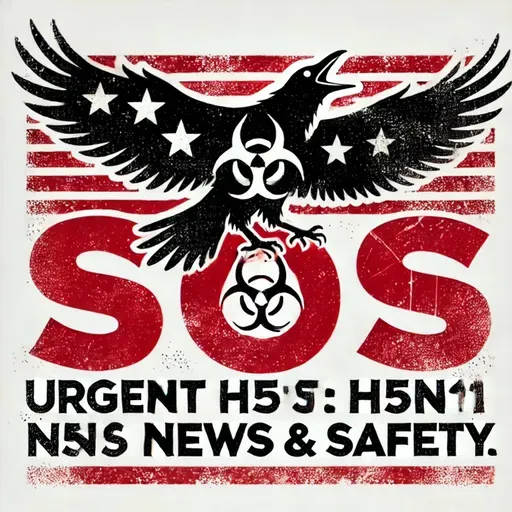
13 September 2025
H5N1 Bird Flu Emergency Escalates: 1000 Dairy Herds Infected, 70 Human Cases Reported Across United States
Bird Flu SOS: Urgent H5N1 News & Safety
About
This is Bird Flu SOS: Urgent H5N1 News & Safety. Today, we face an escalating emergency as the highly pathogenic H5N1 bird flu continues spreading, with recent government reports confirming over 1,000 infected dairy herds in 17 U.S. states and 70 laboratory-confirmed human cases in 2025 alone. In the past month, outbreaks have affected poultry, dairy cows, and even domestic cats, signaling unprecedented multi-species transmission. According to the CDC, the virus continues to circulate intensely, particularly in regions like California, where over 130 dairy herds are infected, resulting in both animal and human fatalities.
Here’s what makes this situation particularly urgent: the Centers for Disease Control and Prevention and USDA have sounded alarms about the virus’s ability to jump between species—including cows, birds, cats, and now humans. CDC Director Dr. Mandy Cohen stated, “The rapid spread and multi-species adaptation of H5N1 is unlike any avian influenza event we’ve previously managed. We urge everyone working with livestock to use heightened protective protocols and immediately report symptoms.” Dr. Michael Osterholm, infectious disease expert at the University of Minnesota, adds, “Novel transmission between animals and humans increases pandemic risk. Public vigilance and early case detection are critical right now.”
If you’re in an affected area, take these immediate steps:
- Avoid all contact with sick or dead poultry, livestock, or mammals, especially on farms and near wild birds.
- Do not consume raw milk or eggs from unknown or symptomatic sources. Pasteurization is essential.
- Farmworkers should use full personal protective equipment—masks, gloves, and eye protection—while handling animals and cleaning facilities.
- Anyone—especially children, elderly, or immunocompromised—experiencing fever, muscle aches, breathing difficulties, or conjunctivitis after contact with animals should seek medical attention immediately.
Warning signs that require emergency response:
- Sudden death or illness in large numbers of birds or mammals.
- Unexplained fever, severe respiratory symptoms, or persistent conjunctivitis after exposure to livestock.
- Clusters of illness among farmworkers or their families.
Resources for emergency assistance include your local health department, state agricultural extension offices, and the CDC’s H5N1 hotline. Major hospitals in outbreak regions have prioritized triage and testing for suspected H5N1 exposure, so notify staff at check-in.
It’s vital to understand: public health authorities are working rapidly to contain the spread, tracking all human and animal cases and activating new testing mandates for milk and livestock. Johns Hopkins Public Health notes cases in birds and mammals have recently declined, but the risk remains high until transmission routes are fully understood.
Remember, knowledge and prompt action prevent panic. Stay informed with official updates and protective measures. Thank you for tuning into Bird Flu SOS—a Quiet Please production. For more information, check out Quiet Please Dot A I. Come back next week for the latest on this and other urgent health alerts.
For more http://www.quietplease.ai
Get the best deals https://amzn.to/3ODvOta
This content was created in partnership and with the help of Artificial Intelligence AI
Here’s what makes this situation particularly urgent: the Centers for Disease Control and Prevention and USDA have sounded alarms about the virus’s ability to jump between species—including cows, birds, cats, and now humans. CDC Director Dr. Mandy Cohen stated, “The rapid spread and multi-species adaptation of H5N1 is unlike any avian influenza event we’ve previously managed. We urge everyone working with livestock to use heightened protective protocols and immediately report symptoms.” Dr. Michael Osterholm, infectious disease expert at the University of Minnesota, adds, “Novel transmission between animals and humans increases pandemic risk. Public vigilance and early case detection are critical right now.”
If you’re in an affected area, take these immediate steps:
- Avoid all contact with sick or dead poultry, livestock, or mammals, especially on farms and near wild birds.
- Do not consume raw milk or eggs from unknown or symptomatic sources. Pasteurization is essential.
- Farmworkers should use full personal protective equipment—masks, gloves, and eye protection—while handling animals and cleaning facilities.
- Anyone—especially children, elderly, or immunocompromised—experiencing fever, muscle aches, breathing difficulties, or conjunctivitis after contact with animals should seek medical attention immediately.
Warning signs that require emergency response:
- Sudden death or illness in large numbers of birds or mammals.
- Unexplained fever, severe respiratory symptoms, or persistent conjunctivitis after exposure to livestock.
- Clusters of illness among farmworkers or their families.
Resources for emergency assistance include your local health department, state agricultural extension offices, and the CDC’s H5N1 hotline. Major hospitals in outbreak regions have prioritized triage and testing for suspected H5N1 exposure, so notify staff at check-in.
It’s vital to understand: public health authorities are working rapidly to contain the spread, tracking all human and animal cases and activating new testing mandates for milk and livestock. Johns Hopkins Public Health notes cases in birds and mammals have recently declined, but the risk remains high until transmission routes are fully understood.
Remember, knowledge and prompt action prevent panic. Stay informed with official updates and protective measures. Thank you for tuning into Bird Flu SOS—a Quiet Please production. For more information, check out Quiet Please Dot A I. Come back next week for the latest on this and other urgent health alerts.
For more http://www.quietplease.ai
Get the best deals https://amzn.to/3ODvOta
This content was created in partnership and with the help of Artificial Intelligence AI